The Indian Child Goes To School
APPENDIX A
List of Schools Participating in the Study
Manual of Instructions
for Test Administration
Background Information Sheet
LIST OF SCHOOLS
PARTICIPATING IN THE STUDY
PHOENIX AREA
Federal Schools
1. Blackwater Day School
2. Bylas Day School
3. Casa Blanca Day School
4. Chuichu Day School
5. Cibecue Day School
6. Colorado River Day School
7. Gila Crossing Day School
8. Hopi High School
9. Hotevilla Day School
10. Keams Canyon Boarding School
11. Kerwo Day School
12. Maricopa School
13. Phoenix Indian School
14. Pima Central Day School
15. Polacca Day School
16. Salt River Day School
17. San Carlos Day School
18. Santa Rosa Boarding School
19. Santa Rosa Ranch
20. Santan Day School
21. Sells Consolidated Day School
22. Shungapovi Day School
23. Theodore Roosevelt Day School
24. Toreva Day School
25. Vamori School
26. Vaya Chin Day School |
Mission Schools
1. Cibecue Mission
School
2. Covered Wells Mission School
3. East Fork Mission School
4. Evangelical Lutheran Mission School
5. Hopi Mission School
6. Our Lady of Guadalupe Mission School
7. Our Savior Mission
8. Peridot Mission School
9. Sacred Heart Mission School
10. St. Anthony Mission School
11. St. Joe San Miguel Mission School
12. St. Johns Mission School
13. St. Peters Mission School
14. San Jose Mission School (Tuscon, Ariz.)
15. San Jose Mission School (Ajo, Ariz.)
16. San Xavier Mission School
Public Schools
1. Fort Thomas Public School
2. McNary Public School
3. North Yuma Union Public School
4. Parker Public School
5. Picacho Public School
6. Poston Public School
7. Rice Public School
8. Sacaton Public School
9. San Taos Public School
10. Sells Indian Oasis Public School
11. White River Public School
12. Yuma Ado Public School |
ALBUQUERQUE AREA
Federal Schools
1. Acomita Day School
2. Albuquerque Indian School
3. Cochiti Day School
4. Consolidated Ute Boarding School
5. Elk Silver Day School
6. Isleta Day School
7. Jemez Day School
8. Jicarilla Boarding School
9. Laguna Day School
10. McCarty Day School
11. Mescalero Day School
12. Nambe Day School
13. Paguate Day School
14. Paraje Day School
15. San Felipe Day School
16. San ildefonso Day School
17. Sandia Day School
18. Santa Ana Day School
19. Santa Clara Day School
20. Santa Domingo Day School
21. Santa Fe Boarding School
22. Seama Day School
23. Taos Day School
24. Tesuque Day School
25. Ute Boarding School
26. Whitetail Day School
27. Zia Day School
28. Zuni Day School |
Mission Schools
1. Allison and James
Mission School
2. Dutch Reform Mission School
3. Our Lady of Sorrows Mission School
4. St. Anthony Mission School
5. St. Catherine Mission School
6. San Diego Mission School
Public Schools
1. Bernalillo Public School
2. Bluewater Public School
3. Bosque Farms Public School
4. Cubero Public School
5. El Gerro Public School
6. El Morro Public School
7. Espanola Public School
8. Fence Lake Public School
9. Flurospar Public School #21
10. Flurospar Public School #27
11. Grants Public School
12. Ignacio Public School
13. Los Lumos Public School
14. Marquez Public School
15. Peralta Public School
16. Pojoaque Public School
17. Ruidoso Public School
18. San Juan Public School
19. San Mateo Public School
20. San Rafael Public School
21. Seboyeta Public School
22. Tome Public School
23. Valencia Public School |
ABERDEEN AREA
Federal Schools
1. American Horse Day School
2. Bear Creek Day School
3. Beaver Creek School
4. Becker Day School
5. Big Coulee Day School
6. Black Pipe Day School
7. Bridger Day School
8. Bullhead Day School
9. Charging Eagle School
10. Cherry Creek Day School
11. Cheyenne River Boarding School
12. Dunseith Day School
13. Elbowoods Community Boarding School
14. Enemy Swim Day School
15. Flandreau Boarding School
16. Fort Thompson Day School
17. Fort Totten Boarding School
18. Fort Yates Community School
19. Four Bear Day School
20. Great Walker Day School
21. Green Grass Day School
22. He Dog Day School
23. Houle Day School
24. Independence School
25. Iron Lightening Day School
26. Kenel Day School
27. Little Eagle Day School
28. Little Wound Day School
29. Loneman Day School
30. Long Hollow Day School
31. Lower Brule Day School
32. Lucky Mound School
33. Macy Day School
34. Moreau River Day School
35. Nishu School
|
36. No. 4 Day School
37. No. 6 Day School
38. No. 7 Day School
39. No. 9 Day School
40. No. 10 Day School
41. No. 16 Day School
42. Old Agency Day School
43. Oglala CommunityBoarding School
44. Pierre Indian Boarding School
45. Red Butte School
46. Red Scaffold Day School
47. Red Shirt Table Day School
48. Ridgeview School
49. Rosebud Boarding School
50. Roussin Day School
51. Sac and Fox School
52. Shell Creek School
53. Slim Butte Day School
54. Standing Rock Boarding School
55. Thunder Butte Day School
56. Turtle Mountain Community Day School
57. Wahpeton Boarding School
58. Wanblee Day School
59. White Horse Day School
Mission Schools
1. Holy Rosary Mission School
2. Immaculate Conception Mission School
3. Little Flower Mission School
4. Lutheran Parochial Mission School
5. Our Lady of Lourdes Mission School
6. Red Shirt Table Mission School
7. Sacred Heart Mission School
8. St. Augustine Mission School
9. St. Bernard Mission School
10. St. Francis Mission School
11. St. Philomena Mission School
12. Tekalawitta Mission School |
ABERDEEN AREA
Public Schools
1. Agency
Public School
2. Batesland Public School
3. Bloom Public School
4. Bob Callies Public School
5. Buffalo County Public School
6. Cannon Bail Public School
7. Carlin Public School
8. Center Public School
9. Demmer Public School
10. Denby Public School
11. Dunselth Public School
12. Dupree Public School
13. Eagle Butte Public School
14. FairfIeld Public School
15. Fairview Public School
16. Faith Independent Public School
17. Fee Public School
18. Glad Valley Public School
19. Happy Hollow Public School
20. High Point Public School
21. Hill Top Public School
22. Hoxing Public School
23. LaPlant Public School
24. Leebelt Public School
25. McIntosh Public School
26. McLaughlin Public School
27. MaIn Public School
28. Manderson Public School
29. Minnewaukan Public School
|
30. MIssion Public School
31. Morristown Public School
32. Mud Butte Public School
33. Oglala Public School
34. O’Kreek Public School
35. Pine Ridge Public School
36. Pourier Public School
37. Redelm Public School
38. Reis Public School
39. Rolla Public School
40.Roosevelt Public School
40. Rosebud Public School
41. St. Francis Public School
42. St. John Public School
43. Selfridge Public School
44. Sioux Rural Public School
45. Sisseton Public School
46. Smee District
47. Spring Creek Day School
48. Thunderhawk Public School
49. Tip Top Public School
50. Tokie Public School
51. Todd County High School
52. Van Dusen Public School
53. Wahpamni Public School
54. Wakpala Public School
55. WalthLll Public School
56. Watauga Public School
57. White River Public School
58. White Swan Public School
59. Wilson Public School
60. Winnebago Public School
61. Zetgler Public School #85 |
BILLINGS AREA
Federal Schools
1. Birney Day School
2. Cut Bank Boarding School
3. Parker Day School
4. Rocky Boy’s Day School
5. Sangrey Day School
6. Tongue River Boarding School
7. Wind River Day School
Mission Schools
1. Ashland Mission School
2. St. Charles Mission School
3. St. Labre Mission School
4. St. Michael’s Mission School
5. St. Paul Mission School
6. St. Stephen’s Mission School
7. St. Xavier Mission School |
Public Schools
1. Arapaho Public
School
2. Beaver Creek Public School
3. Browning Public School
4. Cold Feet Public School
5. Crow Agency Public School
6. Crowheart-Burris Public
7. Dubois Public School
8. Fort Washakie Public School
9. Glacier County (Babb) Public School
10. Glacier Park Public School
11. Hays Public School
12. Hudson Public School
13. Kirkaldie Public School
14. Lincoln Elementary (Harlem Elementary) Public School
15. Lodge Grass Public School
16. Lodge Pole Day School
17. Lower Mill Creek Public School
18. Mad Plume Public School
19. Morton Public School
20. Pavillion Public School
21. Pryor Public School
22. St. Xavier Public School
23. Starr Public School
24. Upper Mill Creek Public School
25. Wind River Public School
26. Winkleman Dome Public School
27. Wyola Public School
28. Zortman Public School |
MUSKOGEE AREA
Federal Schools
1. Bogue Chitto Day School
2. Bogue Homo Day School
3. Chitimacha Day School
4. Conehatta Day School
5. Pearl River Day School
6. Red Water Day School
7. Seneca Boarding School
8. Sequoyali Boarding School
9. Standing Pine Day School
10. Tucker Day School
11. Wheelock Boarding School |
Public Schools
1. Eufaula Public
Schools
2. Goodland Public School
3. Hartshorne Public School
4. Jay Public School
5. Locust Grove Public School
6. Muldrow Public School
7. Vian Public School |
ANADARKO AREA Federal Schools
1. Cheyenne-Arapaho Indian School
2. Chilocco Indian School
3. Fort Sill Indian School
4. Haskeil Institute
5. Pawnee Indian School
6. Riverside Indian School |
Public Schools
1. Alden Public
Schnols
2. Boone Public School
3. Cache Public School
4. Calumet Public School
5. Camp Creek Public School
6. Carnegie Public School
7. Elgin Public School
8. Fort Cobb Public School
9. Verden Public School |
4 through 12
Education Grades
1951 Fall Testing Program
Office of Indian Affairs
MANUAL OF INSTRUCTIONS
FOR
TEST ADMINISTRATION
Purpose
The 1951 fall testing program marks the beginning of a
new phase of evaluation In Indian education. The program this year
is being
concentrated in the Albuquerque and Phoenix areas and will, to
some extent, serve as a pilot study. It is expected that the program
will be extended to other areas in succeeding years, with the benefit
of procedures worked out In this year’s study.
One of the
aims of the program is to provide the education branch with data
by means of which it can evaluate progress toward its
educational goals.
Another, and equally important, aim is to provide
administrators, supervisors, and teachers In the field with data
about children
which will be useful in the Instruction and guidance of those children.
It
should be understood that the items In the tests do not constitute
a list of facts or skills that should be mastered by all pupils
in the Indian schools. These do not in any sense constitute an
approved course of study.
It should also be understood that it is
not the purpose of the testing program to rate the efficiency
of any teacher nor to judge
the quality of Instruction In school.
Schools Participating
It Is planned that all Indian Service schools
in the Albuquerque and Phoenix areas, with the exception of a few
schools remote from
the area headquarters, will participate in the program. In addition,
testing will be carried on in a number of selected public and mission
schools in each area. This cooperative arrangement has been worked
out in order to provide a basis for comparative studies among the
three types of schools enrolling Indian children of similar cultural
background.
Grades to be Tested
All pupils in grades 4 through 12, In the schools
participating, will be tested.
Tests to be Used
The California Achievement Tests (complete battery)
have been selected for use this year. This confines the testing
to the area of basic
skills: reading, arithmetic, and language.
The California Achievement Tests are prepared for three levels:
Elementary including grades 4, 5, and 6; Intermediate, including
grades 7, 8, and 9; and Advanced, including grades 9 through 14.
It will be noted that there is a year of overlap, involving the
9th grade, between the Intermediate and Advanced levels. It has
been determined that all 9th grade pupils will be given the
Intermediate level.
Who Will Give the Tests?
The tests will be administered by trained
teams of test administrators appointed by the directors of
education of the respective Indian
Service areas. It is expected that the teacher of the pupils
being tested will be present in the room while the testing is
in progress.
It is also expected that pupils will be tested
at their own schools and, if possible, in their own school rooms.
Members
of the testing teams will prepare themselves by studying both the
testing manuals and the tests themselves until they are
thoroughly conversant with them.
The Background Information Sheet
The Background Information Sheet
is not a test but is designed to provide information about a pupil
which will be helpful
in interpreting his test scores. The front side of the sheet may
be filled out by the pupil with the teacher’s help, or the
pupil may be asked to provide only such information as the school
records cannot supply. The back side of the sheet must be filled
out by school officials who will refer to the school records. Specific
instructions for the front side of the sheet appear later in this
manual. Specific instructions for the back side of the sheet are
printed on the sheet itself.
(Note: In case the school is boarding-day
school, the school, in the case of an individual pupil, should
be considered either boarding
or day, depending upon whether the individual pupil is a boarding
or thy pupil.)
Persons in charge of test administration are urged
to see that these sheets are filled out in advance of the testing date in order
that this operation will not infringe upon the testing time itself.
The
Sample Questions
Since the tests in this year’s program are
to be machine scored, pupils tested will be required to mark their
answers on
a separate answer sheet. This involves an additional operation
for the pupil and to most of the children it will be a new experience.
In
order to minimize any adverse effects of this factor on the test
results, a sample question and answer sheet has been prepared
for the purpose of practice.
These sheets may be used in advance
of the testing date or immediately before the testing begins.
There is no limitation upon the amount
of help a pupil may have in understanding the technique
of marking the answer sheet. In no case, however, is
the pupil to be given
help in deciding which is the correct answer once the actual
testing has begun.
Specific instructions for using the sample questions appear later
in this manual.
Conditions of Administration
- The room in which the testing is
done should have a blackboard available.
- The room should be
large enough so that students maybe spaced without crowding.
It is desirable to have a desk intervene between
pupils.
- Each student should be provided with a comfortable
chair and a desk on which he can write.
- The test administrator
should have a watch or clock to which to refer.
- When a student
has finished he should sit quietly until the entire group is
ready to proceed or to be dismissed.
- Do not attempt to test
more than 30 or 40 children at one time. The number should
be smaller with younger pupils.
The Testing Schedule
No attempt will be made to set up in this
manual a rigid schedule for administering the tests. However, there
are some basic considerations
which should be adhered to:
- The entire battery should be administered
on the same day.
- The sections of the test must be administered
in the order in which they appear in the test booklet.
- Provision
must be made for adequate rest periods. These may be at the
discretion of the test administrator but they
should
always fall between the six major sections of the test battery.
The length and frequency of rest periods should depend upon
such factors as the age and mental maturity of the pupils,
temperature,
etc. It is well to make sure that the pupils move around
during rest periods and preferably go outdoors to play if possible.
The noon hour will of course provide one intermission.
Two Points to
Stress with Pupils
- Because the tests are to be scored with
a machine it is absolutely necessary that a special
electrographic pencil be used. A supply
of these pencils is being shipped with the tests. Pupils may
have favorite pencils of their own or inadvertently pick up an
ordinary
pencil. Consequently it is necessary to repeatedly remind pupils
to use the special pencils. The machine will not score sheets
marked with ordinary pencils, regardless of how soft the lead
may be.
- Care must be taken that pupils do not write or make
any marks whatsoever on the test booklets. When special machine
scored answer
sheets are used, the test booklets may be used repeatedly if
they are not defaced. Great vigilance must be exercised, however,
to
be sure that the pupils do not forget.
Test Manuals
This mimeographed manual contains general instructions
for the testing program and specific instructions for the Background
Information
Sheet and the Sample Questions. Specific instructions for the California
Achievement Tests are printed and are supplied by the California
Test Bureau with the tests. One copy of the manual is packed with
each package of 25 copies of the test booklets. Persons administering
the tests should make sure that they are using the directions for
tests which are to be machine scored. These directions begin on
page 18 of both the elementary and advanced manuals and on 19 of
the intermediate manual. Persons administering the tests should
familiarize themselves thoroughly with the instructions for
administering the tests and with the tests themselves.
No Handwriting
Test
No handwriting test will be given and any reference to the
handwriting test in the manual may be disregarded.
The Answer Sheets
Each pupil, in the course of taking the tests,
will use three different answer sheets, one each for reading, arithmetic,
and language.
Since these come at three different levels, elementary, intermediate,
and advanced, the test administrator will be working with nine
different types of answer sheets. Care must be taken not to get
them confused.
Sec that each pupil fills out completely the information
called for on the answer sheets. Also, during the progress of the
testing,
persons proctoring the examination should check constantly to be
sure the pupils are not confused as to the section of the answer
sheet in which they should be marking.
Complete instructions for
using the answer sheets are included in the printed manuals.
Time
Limits
Time limits for the various sections of the California Achievement
Tests are suggested in the manual. However, inasmuch as the tests
are ‘power’ rather than speed tests, these suggested
limits need not be adhered to rigidly. On the other hand, it is
not practicable to wait until all stragglers have finished a section.
It is recommended that time be called when about 90% of the group
have completed the section.
Preparing the Roster
Rosters of pupils taking the tests are to
be prepared in duplicate. Both copies are to be returned with the
answer sheets. Please use
typewriter or, in the event a typewriter is not convenient,
print by hand.
Be sure that all information called for at the top
of the page is supplied. By “Type of School’ is meant
whether Indian Service, public, or mission, and whether day, reservation
boarding, or non-reservation boarding. By “date’ is
meant date the tests were administered to the pupils listed below.
Make
a separate roster for each grade tested in each school. More
than one sheet may be used for a grade if required.
List the pupils
in alphabetical order on the roster. Also, stack the completed
answer sheets in alphabetical order for the pupils
listed on the roster. Clip the answer sheets and both copies of
the roster together and return as directed below.
Returning the
Answer Sheets and Rosters
Completed answer sheets and rosters must
be returned by mail, first class. Whenever possible these should
be mailed under government
frank.
It is important that the answer sheets not be folded or allowed
to become “dog-eared” since this will make it impossible
to put them through the scoring machine. Pack all answer sheets
flat and reinforce the bundles of answer sheets with firm pieces
of card-board.
Mail the answer sheets and rosters to:
The Guidance Bureau
University of Kansas
Lawrence, Kansas
These answer sheets and rosters should be mailed
as soon as the testing is completed in any grade in any school.
Promptness
in returning the answer sheets will help to insure promptness in
getting the test results back to the schools.
The Guidance Bureau of the University of Kansas will
score tests only for pupils who have completed all sections of
the test. Therefore,
do not send in partial or incomplete data for a pupil. For
example, do not send in the reading and arithmetic answer sheets
for a pupil unless he has also taken the language test.
Returning
Other Supplies
The electrographic pencils belong to the central
testing office and are to be used in subsequent testing programs.
Be sure to recover
these pencils from the pupils, repack them in the boxes and
ship them by parcel post. There may be some loss on these pencils
but it should be held to a minimum.
The test booklets, test manuals,
and unused copies of answer sheets, background information sheets,
and sample questtion sheets also
should be returned. There is not the same urgency about the return
of these items, however, as of the marked answer sheets, rosters,
and pencils. Consequently, these may be shipped by freight, if
desired.
Send all items under this heading to:
L. Madison Coombs
Education Specialist
Haskell Institute
Lawrence, Kansas
SPECIFIC INSTRUCTIONS
BACKGROUND INFORMATION
SHEET
- See that all students have pencils.
The special electrographic pencils are not necessary for this
sheet, but they maybe used if
desired. Pen and ink may
be used if preferred.
- Distribute the sheets with the side headed, “Background
Information” face
up. (Instructions for the reverse side are printed on the sheet itself.)
- Say:
“On the sheet which you have been given I want you to
fill in some information about yourself. I will help you as
we go
along. Do not write anything at all
on the back of the sheet.
“Write the date on the first line.” (Write the
date on the blackboard.)
“ After the number ‘1’ write your first name first, then your
middle name, then your last name. Be sure to write clearly.” (Printing
or manuscript writing is desirable.) “If you are a boy, put a check mark
after ‘Boy’;
if you are a girl put a check mark after ‘Girl’.
“ After number ‘3’ write the name of this school.” (For
younger students write the name of the school on the blackboard.)
“ After number ‘4’ put a check mark in the blank after . . .
. . . .(indicate the appropriate blank, depending upon the type of
school being tested.)
“Number ‘5’ asks whether you are Indian or white. Put a check
mark in the space after ‘Indian’, if you are Indian, and in the space
after ‘white’, If you are white.” (If all of
the pupils in the group are Indian, recognition of that fact may
be made).
“ Number ‘6’ asks you, if you are Indian, to state your degree
of Indian blood. If you are a fullblood, write the word. ‘full’ in
the space at the right. If you are one-half Indian blood, you should write
the fraction 1/2 in the space. If you are three-fourths Indian you should
write the fraction 3/4, etc.” (The person administering the tests
should write these and other applicable fractions on the blackboard.
Be sure to give
students
all the help they need in answering this question.)
“ After number ‘7’ write . . . . . . . . (name the grade or
grades.)
“ Number ‘8’ asks how many years old you are now. If you have
reached your tenth birthday, you will write ‘10’. If you will soon
have your tenth birthday, but have not yet reached it, you will write ‘9’.
“ After the number ‘9’ write your birthday.” (Help students
in computation of their birth year. Be sure these are as accurate
as possible.)
“ Number ‘10’ asks how old you were when you first started to
school.” (The
younger students may need assistance In this computation.)
“ Number ‘11’ asks what languages you could speak when you first
started to school.
Place a check mark after the correct answer. If you could only
say ‘Yes’ or ‘No’.
or ‘Hello’ in English, but always spoke in Indian to your parents,
put a check mark after ‘Indian only’. If you spoke neither English
nor Indian when you first started to school, but some other language such as
Spanish, write the name of that language in the space after ‘Only’.” (Check
closely on the accuracy of the student’s responses.)
“Number ‘12’ asks how many years you have gone to school,
including this year. Count all the years you have gone to school,
including years
when you did not attend the whole year.”
“Number ‘13’ asks what schools you have gone to. List
all the schools you have attended, starting with the one where
you were a beginner. You
are
also to show whether each school was a government, public, or mission
school, whether it was a day, boarding, or non-reservation school and what grades
you
were in at that school.” (Help the students to answer this
item accurately.)
“Number ‘14’ asks, ‘Where is your permanent home?’ You
are to make check marks in the right spaces, and write in the other
information called for.” (Boarding school students should respond to
this in relation to the home of their parents, or the location
where they
usually
spend their vacations. It will 1robably be necessary for you to
help some students
with the distances from towns and the approximate population of
towns. Give all the help necessary to insure accuracy,)
“ Number ‘15’ asks, ‘Who are your friends?’ This
means, ‘With
whom do you play?’ (The accuracy of the responses to this
question is important.)
“ Alter 16’ check. . . . . . . .(Give the students the proper information.)
“
Alter number ‘17’ write the number which tells the
grade you expect to ftrii1sh before you stop going to school. How
long
do you expect
to attend
school?”
-
Do not permit students to write on the back side
of the sheet. When students have finished the front page, collect
the papers.
SPECIFIC
INSTRUCTIONS
SAMPLE QUESTIONS No Time Limit
- See that each student has
a special electrographic pencil with an eraser.
- Say:
“
You are going to take some tests today, but first you axe to
have some practice on how to mark your answers. These tests are
probably
a little different from
any you have taken before, in that instead of marking your
answers on the test booklet, you mark them on a separate answer sheet. This
does not
make the
test
any harder, but we want to be sure that you know how to
go about marking the answers.
“
In just a moment I am going to give you a sheet of paper with
some sample questions on it. Do not make any marks on this paper
until
I tell you to do so. I will
explain carefully what you are to do as we go along.”
- Distribute the Sample Question Sheets.
- Say:
“ Now look at the sheet which has been given you. You will notice that
there are some Sample Questions above the line which runs across
the page and some
Answer Spaces below it. Think of the Answer Spaces below
the line as if they were on a separate sheet of paper, for they will be on a
separate
sheet
when
you take the tests.
“
Now look at question 1 under ‘Test 1--Section A’. You see two words, ‘b-e-e-t’ and ‘b-e-a-t’.
Are these two words the same or are they different? Are they spelled the same?
No, they are different. Now look at the Answer Spaces below the line, under
Test 1--Section A. At the right of the number ‘1’ are two answer
spaces, one with ‘S’ above it, and the other with ‘D’ above
it. Since the words In this question are different from each other, take your
special pencil and make a heavy black mark within the pair of dotted lines
under ‘D’. Make the mark as long as the pair of dotted lines and
move your pencil up and down firmly to make a heavy black line.” (Demonstrate
on blackboard.)
“
Now look at question 2 under ‘Test 1--Section A’. You see two words, ‘c-o-m-p-a-r-e’ and ‘c-o-m-p-a-r-e’.
Are these words the same or are they different? Yes, they are exactly the same.
Now find the answer spaces to the right of the number ‘2’ under
Test 1--Section A below the line. Since the words in this question are the
same, make a heavy black line with your special pencil between the pair of
dotted 1[ne8 under ‘S’.”
(Check to be sure that all the children are finding the
correct answer spaces and are marking them properly.
Give whatever
help Is needed
to insure correct
marking of the answer spaces.)
“
Now look at question 3 under ‘Test 1--Section C’.
Toward the left hand side the sheet see the word ‘bright’.
Toward the right hand side of the page see four words, ‘eat’, ‘small’, ‘dark’,
and ‘read’, numbered 1, 2, 3, and 4. You
are to mark the number of the word that means the opposite
or
about the opposite of the first word. Which of the four
numbered
words means
the opposite
of ‘bright’?
(Let the group respond.) “Yes, ‘dark’,
the word with the small 3 above it, is correct. Now,
look at the
answer
spaces under
Test 1--Section
C at the right of the small heavy black 3. Make your
heavy black mark within the pair of dotted lines under
the small
light black
3.
“
Now look at question 4 under ‘Test 1--Section C’. The first word
is ‘early’ and the other words are ‘walk’, ‘late’, ‘lock’,
and ‘myth’. Which of these four words means the opposite of ‘early’?
Yes, ‘late’ is correct and it is number 2. Now find the second
answer space for question 4 under Test 1--Section C and make your heavy black
mark.” (Check to see that the students are marking
the paper correctly and that they are beginning to understand
the
procedure.)
“
Now look at question 5 under ‘Test 1--Section D’. This is much
the same as ‘Section C’, above, except that here you are to mark
the number of the word at the right which means the same as the word at the
left. Which word means the same, or about the same, as ‘talk’?
Yes, ‘speak’ with the number 4 above it. Now find the fourth space
for question 5 under Test 1--Section D in the answer spaces below and make
your heavy black mark. Now do question 6 under Test 1--Section D. What word
means the same, or about the same as ‘walk’? Yes, ‘stroll’,
number 1, is correct. Make your mark in the first answer
space for question 6 under Test 1--Section D.
“
Now look at question 1 under ‘Test 3--Section A’. At the left see
the word ‘twelve, spelled out. At the right of the word ‘twelve’ see
four numbers: ‘10’, ‘12’, ‘24’, and ‘2’,
and the word ‘None’, with the letters a, ~. c, d, and e before
them. For some of the problems none of the answers given may be correct. If
you cannot work a problem, or if you think that none of the answers given is
correct, mark the letter ‘e’. What letter does the number, 12,
have in front of it? Yes, •‘b’ is correct. Therefore, you
should make a heavy black mark under the ‘b’ in answer row ‘1’,
under Test 3--Section A in the answer spaces.
“
Now look at question 2 under ‘Test 3--Section A’.
The words, ‘one
hundred two’ are spelled out. What is the letter
in front of the number ‘102’ at
the right? Yes, ‘c’ is correct. Make a heavy
black mark under the ‘c’ in
answer row ‘2’ under Test 3--Section A in
the answer spaces.”
- See that each student is
supplied with a sheet of scratch paper.
- Say:
“
Now look at question (3), in parentheses, under ‘Test 4--Section D’.
Have your scratch paper ready. You need not copy any problem. Just place your
scratch paper under the problem, then do your figuring. Remember not to do
any figuring on the question sheet.” (Demonstrate how to place the scratch
paper, if necessary.) “This is a problem in addition. What is the correct
answer?” (Wait until the students have had time to find the answer and
then allow the class to respond.) “Yes, ‘39’ is the correct
answer. Do you find ‘39’ among the numbers at the right? Yes. What
letter is in front of it? That is right, ‘d’. Now make your mark
under ‘d’ in answer row (3) under Test 4--Section
D in the answer spaces.
“
Now look at question (4) under ‘Test 4--Section
D’.
Do it in the same way. What is the correct answer?
Yes, ‘34’.
What is the letter in front of ‘34’?
Yes, ‘a’ Now make your mark under ‘a’ in
answer row (4) under Test 4- -Section D in the answer
spaces.
-
Check to see that all have marked the sheets
correctly and collect the sheets and the scratch
paper.
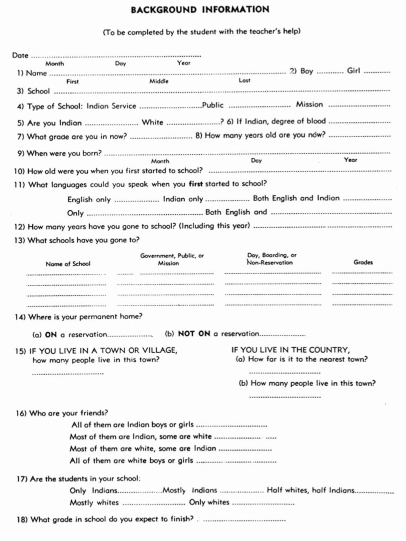
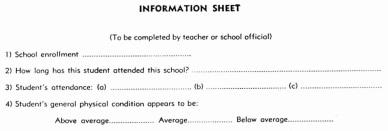
INSTRUCTIONS
(For filling in above)
- School enrollment is the
total number of students enrolled in the school during the 1953-54
school year thus far.
- Give the total number of years that the
student has attended this school, including the 1953-54 academic
year. Count every
year in which he was enrolled and attended for a month or mare.
- Three entries are required to describe attendance:
- Enter on
the first line the total number of days of school offered
during the school year just past, 1952-53, not the current
school year.
This figure indicates how many days the student could have
been in school if he had attended regularly. Boarding schools
should
count only the number of days on which a regular
classroom was in operation.
- On the second line, enter the number
of days the student was absent from this regular classroom
program during the 1952-53
school
year, if he was attending your school at that time. If a
boarding school student was absent on a Sunday, for example,
this would
not be included in this figure.
- On the third line indicate
whether your program last year was a day program,
in which students returned home each
afternoon;
a five-day boarding program, in which students
lived at the school Monday through Friday; or a full
boarding program,
in which the
students lived at the school throughout the school year.
-
Check one of the three spaces which, in your judgment,
best describes the student’s general physical condition
at present.
APPENDIX B
Mothod for Determining the Area Hierarchy of Achievement
| Table B-1 |
Order of Areas at the Mean on the Several Skills |
| Table B-2 |
Comparison of Means of Normalized T-Scores Assigned to Ranks
of Areas |
| Table B-3 |
Number, Mean, and Standard Deviation by Grade and Areas |
The first step in securing a general hierarchy of the areas with
regard to achievement was to establish an ordering of the six areas
on each of the
achievement tests for each grade. The ranks of mean (average) achievement for
each grade are shown in Table B-i. The table should be read by going across
the rows. For instance, we find that fourth graders in the Anadarko area had
the highest mean score for the reading vocabulary test, the Aberdeen area fourth
graders had the second highest mean, and so on to the Phoenix area whose fourth
graders had the lowest mean on this test.
The table can be read down the columns,
too, to obtain a picture of the consistency with which a particular
area held a rank throughout the grades tested. A study
of the table will show that there was some variability of ranks among the areas.
The question which is then posed is: Can the ranks of area mean achievement
be “averaged” in some way to give an over-all picture of the ranks
of the areas in all skills and grades?
Ranks, as such, cannot be added and averaged
since they do not take account of the size of differences between ranks.
A method is available however by
which normalized standard scores are assigned to ranks. These scores are
positioned along the distribution curve of normal probability.
They have a mean of 50
and a standard deviation of 10. As the number of ranks changes, the specific
standard scores which are used changes, but for any series of ranks the scores
always have a mean of 50.
When six categories are ranked the first rank has
a score of 64, the second a score of 57, the third 52, the fourth
48, the fifth 43, and the sixth 36.
These scores are shown at the top of each column in Table B-i. Thus we see
that for reading vocabulary the scores assigned to the Aberdeen area from
grade 4 through 12 were 57, 52, 52, 57, 57, 57, 57, 57, and 57. The sum of
these
scores is 503 and their arithmetic average is 55.89. This mean standard score
for the Aberdeen area can then be compared with the mean on reading vocabulary
for each of the other areas.
(The Anadarko and Muskogee area raw score means
were not significantly different from each other for any of the
seven achievement tests in the tenth, eleventh,
and twelfth grades. Both areas were therefore combined on this level. For
the purpose of ranking, these Oklahoma areas were both listed for two adjacent
ranks in the three grades mentioned. The standard score assigned to each
area
was the mid-point between the standard scores assigned to the two adjacent
ranks. Thus six ranks were always maintained. Each area was then ranked sixty-three
times, i.e., in nine grades on seven tests.)
The standard scores assigned
to the rankings of an area for all grades in all seven skills were
added and averaged to obtain the general hierarchy.
The mean
standard score of each area was as follows:
Anadarko
Billings
Aberdeen
Muskogee
Albuquerque
Phoenix |
57.65
55.94
53.86
49.00
43.37
40.00 |
Standard deviations were calculated on the standard scores for
each area. Tests for the significance of the difference between
means of standard scores
were
then made. The results of these tests of significance of difference are shown
in Table B-2. These may be summarized by saying that there was no significant
difference between mean rank scores of the Anadarko and Billings areas but
the differences between all other pairs of means were significant. Significance
was here defined to be at the .05 level of confidence. By this it is meant
that a difference as great as or greater than the observed difference in
means would have occurred less than 5 times in 101) by chance alone. The
difference
between the means for the Billings and Aberdeen areas very closely approached
the .05 level of probability.
The method of assigning normalized standard
scores to ranks, and the tables of standard scores may be further
investigated by referring to “Tables
for Transmutation of Orders of Merit into Units of Amount or Scores” by
Kenneth E. Anderson, Robert T. Gray, and Einar V. Kullstedt, in the Journal
of Experimental Education, 1954, XXII, 247-256.
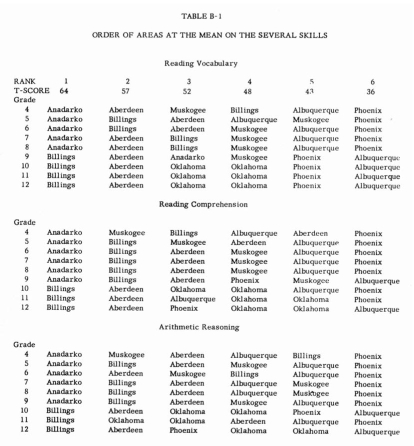
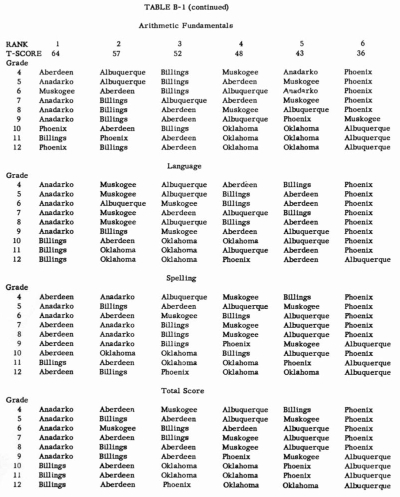
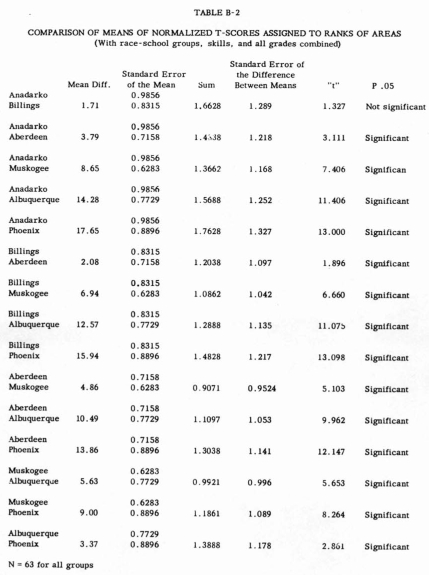
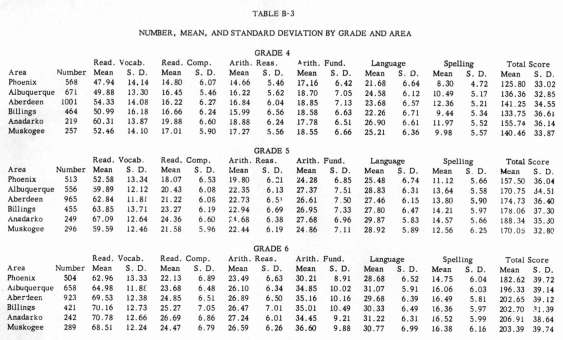
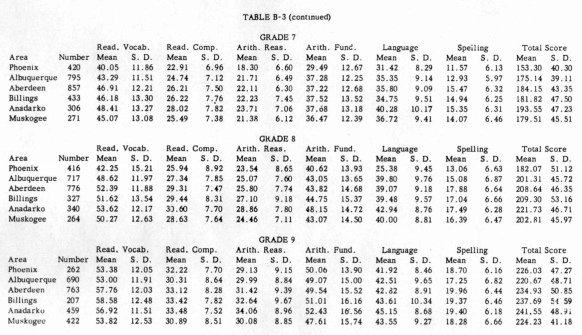
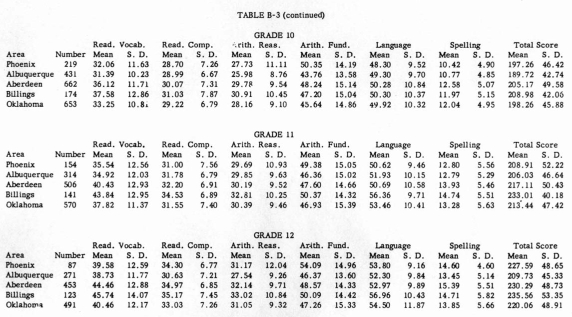
|